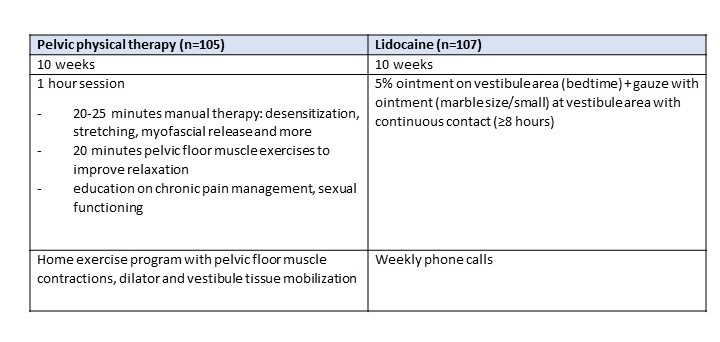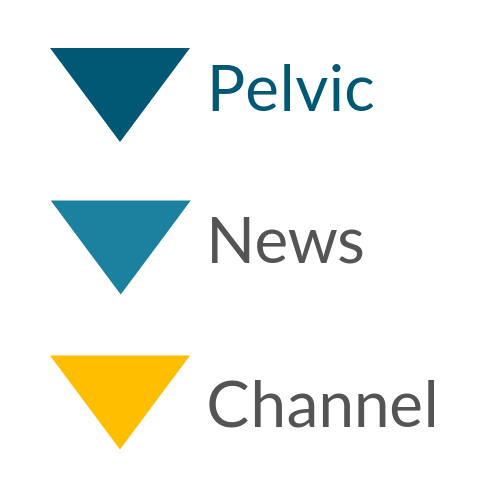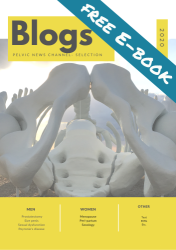Again great research from our Canadian colleagues. This time I will discuss their randomized controlled trial on the efficacy of physical therapy in women with provoked vestibulodynia compared to the application of overnight topical lidocaine.
First I will give a very short introduction with links to other articles for those of you who want to go deeper into this topic. Then I will discuss the research methodology with the results followed by the clinical implications of the results for the pelvic physical therapist*.
*pelvic physical therapist= physical therapist with education regarding pelvic region, pelvic floor dysfunctions.
Symptoms of provoked vulvodynia are: pain when pressure is given at the vulvar vestibule and/or during penetration. The cause of this chronic condition is uncertain and it does not respond well to pain medication like for instance tricyclic antidepressants. At the moment 5% lidocaine administered locally overnight is often prescribed. However pelvic physical therapists also treat women with provoked vestibulodynia with a variety of treatment modalities like: pelvic floor exercises, dilation, relaxation and education (pain management).
Why did they do this study?
Up to now there was no randomized controlled trial on the effect of pelvic physical therapy for the treatment of provoked vestibulodynia. However, smaller (pilot) studies showed promising effects. Therefore they did this randomized controlled trial to determine the efficacy of physical therapy in women with provoked vestibulodynia compared to overnight topical lidocaine.
How was the research executed?
Population:
- Nulliparous women (n=212)
- Aged 18 – 45
- >6 months of pain during sexual intercourse (pain intensity, NRS ≥5)
- Diagnoses confirmed by gynecologist
Main exclusion criteria:
- Other urogynecological/ vulvar pain conditions
- Physical therapy/ overnight lidocaine before
- Medical conditions that might disrupt study procedure
Interventions:

Outcome:
Measurement at: baseline, post-treatment, 6 month post-treatment
Primary outcome:
- Average pain intensity during intercourse (NRS: 0= no pain, 10=worst possible pain)
Secondary outcomes:
- McGill-Melzack pain questionnaire (MPQ)
- Female Sexual Function Index (FSFI)
- Female Sexual Distress Scale (FSDS)
- Satisfaction with treatment (0=completely dissatisfied, 10=completely satisfied)
- Adherence to treatment
- Side effects
What are the results?
Primary outcome: both groups significant reduction in pain. Physical therapy significantly better (baseline NRS: 7.3, post-treatment: 2.7, 6 months post-treatment: 3.0) than lidocaine post-treatment and 6 months post-treatment (baseline: 7.3, post-treatment: 4.5, 6 months post-treatment 4.8).
Secondary outcomes: both groups improved significantly for all outcomes. However, the physical therapy group showed significantly better results regarding pain intensity, quality and sexual function and distress. This result remained at 6 months post-treatment.
Treatment satisfaction was significantly higher in the physical therapy group (post-treatment: 8.9, 6 months post-treatment: 8.5) compared to the lidocaine group (post-treatment: 5.6, 6 months post-treatment 5.2).
Adherence: treatment group (6 drop-outs), other women attended all sessions, home-exercise median 85%. Lidocaine (5 drop outs), median 9f1%.
Adverse events: physical therapy group: none, lidocaine group: 1 participant: dermatitis an 15% minor irritating or burning sensation.
Clinical implications for the pelvic physical therapist?
The results of this well designed randomized controlled trial confirm that pelvic physical therapy is an effective and therefore important treatment option for women with provoked vestibulodynia. Therefore I think it is important that besides physicians also women with provoked vestibulodynia should be aware of this research and the results.
This research can help physicians by referring patients with provoked vestibulodynia to qualified pelvic physical therapist and pelvic physical therapists in their communication with other healthcare providers on this topic. Important factor is that the pelvic physical therapist is well educated!
The women in the physical therapy group had 10 sessions of 1 hour each so a total of 10 hours. The reimbursement of 10 hours of physical therapy might be an issue. However, I think that it is important to follow the complete protocol for an optimal, evidence based, result.
This therapy for provoked vestibulodynia is given by physical therapists with experience and education regarding pelvic floor dysfunctions and pain management. In another blog I discuss the great results of treatment of primary vaginismus with exposure therapy, given by a psychologist/sexologist. Of both provoked vestibulodynia and primary vaginismus the etiology is not well understood, however the therapy shows a lot of similarities.
Reference:
Morin M, Dumoulin C, Bergeron S, Mayrand M-H, Khalifé S, Waddell G, Dubois M-F, For the PVD Study Group, Multimodal physical therapy versus topical lidocaine for provoked vestibulodynia: a prospective, multicentre, randomized trial, American Journal of Obstetrics and Gynecology (2020), doi: https://doi.org/10.1016/j.ajog.2020.08.038.









Hi my friend! I wish to say that this article is amazing,
great written and come with approximately all vital infos.
I’d like to see extra posts like this .